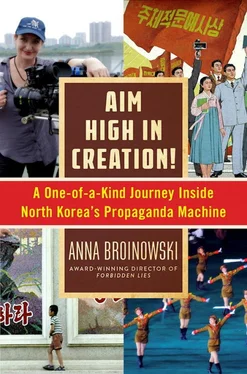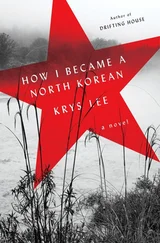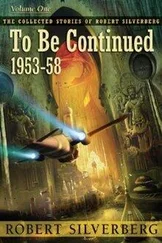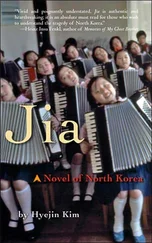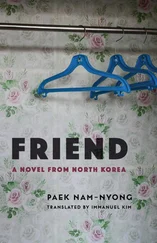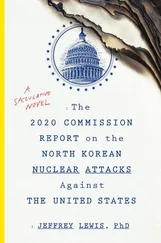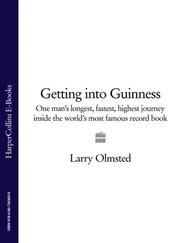“On your left is Kim Il Sung Square,” Ms. K says loudly, as if she can sense what I’m plotting. We’re driving past a Sahara of concrete, flanked by huge buildings. I recognise it from the news—this is the famous square from which Kim Jong Il broadcast his parading soldiers every time the US or South Korea did something to annoy him. Today, it’s empty. A few women stroll in the distance, under pretty pastel parasols. A massive cutout of a man holding a bugle sits silently against the sky above a slogan: Let us carry out this year’s military tasks! To his right and left are two huge halls, all gilt and marble, with more slogans: Let us uphold our great Party by changing our sadness to courage! Let us make 2012 full of proud victories of our strong and prosperous nation as per our Comrade Kim Jong Il’s departing teaching! From the Grand People’s Study House, an Asian palace as big as the Vatican, Kim Jong Il’s visage smiles down at the deserted square, full of papal love.
Kim disappears from view and a grassy hill appears, crowned by a rearing bronze Chollima. The horse stands forty-six metres high and is exquisitely cast. This is not the cheap patriotism my country trundles out each Australia Day—all corkboard murals, nylon banners, and flags made in China; North Korean symbology has been built to last. Its artists may have limited subject matter, but their execution is brilliant. We enter a roundabout and glide around an ostentatious white granite riff on the Arc de Triomphe. This one, Ms. K tells us with pride, is ten metres higher than the one in Paris. Lizzette nods, impressed, but I’m starting to feel nervous. The Pyongyang Film Studio is the most powerful propaganda factory in North Korea—and, if you don’t count Hollywood, the world. I doubt they tolerate slothful Western idiots who haven’t done any homework. I pull out the copy of Great Man and Cinema Johannes gave me in Beppu, trying to get myself into a suitably reverent frame of mind…
23 frames
This is what happened when Comrade Kim Jong Il examined one film.
The creators appreciated the film’s scenes and music, deeply enthralled by them. But Comrade Kim Jong Il said quietly, “Stop projecting.” The creators wondered why, looking at each other.
Comrade Kim Jong Il asked the director if any shots were cut off in the editing. The director was at a loss, because he had examined every scene, shot by shot. Comrade Kim Jong Il asked the composer. “Have you sensed anything different?” The composer answered that he had not. “That’s not true. I am sure several shots were cut off. Find them,” said Comrade Kim Jong Il, and left.
The creators ransacked all night the piles of film that had been cut. At daybreak the director ejaculated abruptly, “I’ve found it!” He was holding a 23-frame strip of film.
The creators doubted it was the right one, because it was only one second. But they had no choice but to put the 23 frames back in the film.
Comrade Kim Jong Il visited again. When the projection was over, he lightly slapped his knee and said in joy, “All right! You found it! Thank you. The scene now exactly harmonizes with the music.”
This was really beyond imagination, for any man without a keen sense of detecting the minute flow, that flashes away like lightning.
GREAT MAN AND CINEMA
When I look up fifteen minutes later, Pyongyang’s statues and boulevards are gone. We’re bumping along a narrow road dissecting a cornfield, bordering what looks like a nineteenth-century village. Farmers idly herd cows out of our path. Women in straw hats pull reeds from the mud. A man ploughs the field with an oxdrawn cart. It is unbelievably clean and completely pre-digital: no ads, no plastic bags, no technology. We swerve around a pack of bicyclists, scattering chickens in our wake. Pyongyang has more environmental cred than Amsterdam, if you ignore the fact that its lack of cars and commitment to urban farming are due more to the limited means of its citizens than to any climate-driven ideology.
The road degenerates into a patchwork of concrete and dirt, and a loud beep causes our driver, and everyone else on the road, to swerve in alarm. A brand-new armour-plated Range Rover glides past, the van shuddering in its slipstream. Ms. K points at some cinematography students filming further down the road, as if the SUV isn’t there. I ignore her and peer into the tinted windows, trying to catch a glimpse of Kim Jong Un. Is he in there with his new pop-singer girlfriend right now, drinking tequila and playing Angry Birds on his iPad? Or does he travel only after the 7 p.m. curfew, in army-protected cavalcades?
I whisper to Eun: “Your Great Leader Comrade Kim Jong Un, where does he live?” She shrugs. I try again: “What about your Dear Leader Kim Jong Il, where was his palace?” Eun glares at me, as if it’s obvious: “I don’t know.” I’m astonished. Kim Jong Il’s palaces were legendary among the leaders of the developing world. They enjoyed lavish banquets and drunken dances with the girls of Kim’s Joy Division, sometimes in the nude. How can the North Koreans not know where their Leaders live? Before I can push Eun further, Ms. K says something in Korean, and Eun looks pointedly in the opposite direction. The Range Rover disappears in a cloud of dust. Maybe it was only one of the generals from North Korea’s military parades. Hell, maybe I never saw it at all.
The cows and bicyclists return to their pre-industrial crawl, and we round a wide bend. Rising up to meet us, above the chickens and tethered goats, is the magnificent gate of the Pyongyang Film Studio. Kim Il Sung beams down from the arch, like Rapunzel at the top of her tower. A girl with a Kalashnikov slung sexily on her hip presses a red button on the wall. I’ve dreamt of this moment for a long time. The gate slides open. We’re inside.
The compound is huge, full of square buildings and wide roads—like the MGM back lot, but bigger. In the central courtyard, a massive bronze statue of Kim Jong Il holds a camera, flanked by adoring children. Facing him are the two buildings that Shane Smith penetrated in North Korean Film Madness: the cinema museums of Kim Il Sung and Kim Jong Il. On the wall of Kim Jong Il’s museum is a mosaic as big as a football field, celebrating the contribution of North Korea’s filmmakers to the nation’s flowering soul. Even Sunmo’s work did not prepare me for this: it is the most beautiful propaganda art I have seen.
From a distance, the mosaic is an explosion of colour, with film crews pointing cameras at the horizon like bayonets. Behind the crews, men and women in shirtsleeves wave revolutionary banners, surrounded by clapping workers. Rising above them are charging soldiers, yelling at an invisible enemy. And bursting through a halo of clouds at the top, like a North Korean Jesus, is Kotpun the flower girl—cradling her basket of glorious red blooms. It would be kitsch if it weren’t so exquisitely done. The grandeur is breathtaking. I walk closer to examine the tiny hand-painted tiles and realise why I feel so uplifted. It’s the first mural I’ve seen without a Kim in it. I sit in the grass, dazzled.
Ms. K cuts my reverie short, calling from a stone building next door. She looks irritated behind her tight smile: lounging on lawns and asking for the Kims’ addresses are not part of her itinerary. I promise myself I’ll shoot the mosaic next time and follow her up the steps. The entrance is hung with movie posters of bosomy heroines and granite-jawed men: a Pyongyang take on Bollywood. Above them is a slogan, which Eun translates in a bored monotone, ignoring the enthusiastic punctuation: Let us create masterpieces in our own way, portrayals by no means inferior in any aspect!!!
We enter to find a large mural of Kim Jong Il rocking his Mao suit, with babes in flowing gowns hanging off him like groupies at a Liberace concert. Then we climb a marble staircase and step inside a spacious room. A stunning collection of mid-century furniture is spread over the parquetry floor. It looks like Eames, low-slung and elegant—but this stuff really was made in 1953: the last furniture, perhaps, to make it over the border. Two unusually solemn Kims look down from one wall, facing a beautiful trompe l’oeil of swans in a misty green pond. I register all this in a few seconds, then forget it, as I see, sitting in the middle of the room, Kotpun’s brother from Flower Girl . After four decades, he still looks like Harrison Ford—but the Patriot Games version, rather than Han Solo. His name is Yurim. He is the most famous actor in North Korea.
Читать дальше
